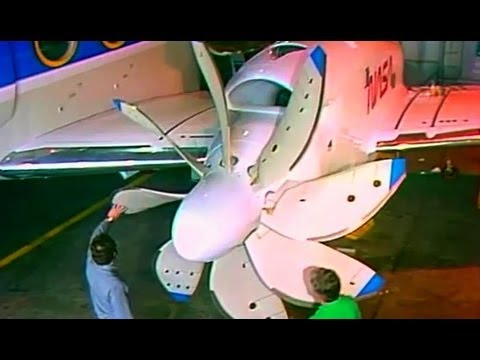more at
“The video shows the unique propfan design. The propfan is designed to achieve the speeds and altitudes of jets while only using half the normal amount of fuel.”
Public domain film from NASA, slightly cropped to remove uneven edges, with the aspect ratio corrected, and mild video noise reduction applied.
The soundtrack was also processed with volume normalization, noise reduction, clipping reduction, and/or equalization.
A propfan was first defined as a small diameter, highly loaded multiple bladed variable pitch propulsor having swept blades with thin advanced airfoil sections, integrated with a nacelle contoured to retard the airflow through the blades thereby reducing compressibility losses and designed to operate with a turbine engine and using a single stage reduction gear resulting in high performance. The propfan concept was first revealed by Carl Rohrbach and Bruce Metzger of the Hamilton Standard Division of United Technologies in 1975 and was patented by Robert Cornell and Carl Rohrbach of Hamilton Standard in 1979.
Later work by General Electric on similar propulsors was done under the name unducted fan, which was a modified turbofan engine, with the fan placed outside the engine nacelle on the same axis as the compressor blades. Propfans are also known as ultra-high bypass (UHB) engines and, most recently, open flux rotor jet engines. The design is intended to offer the speed and performance of a turbofan, with the fuel economy of a turboprop…
Limitations and solutions
Propeller blade tip speed limit
Turboprops have an optimum speed below about 450 mph (700 km/h). The reason is that all propellers lose efficiency at high speed, due to an effect known as wave drag that occurs just below supersonic speeds. This powerful form of drag has a sudden onset, and led to the concept of a sound barrier when it was first encountered in the 1940s. In the case of a propeller, this effect can happen any time the propeller is spun fast enough that the blade tips near the speed of sound, even if the aircraft is motionless on the ground.
The most effective way to counteract this problem (to some degree) is by adding more blades to the propeller, allowing it to deliver more power at a lower rotational speed. This is why many World War II fighter designs started with two or three-blade propellers and by the end of the war were using up to five blades…
A method of decreasing wave drag was discovered by German researchers in 1935—sweeping the wing backwards. Today, almost all aircraft designed to fly much above 450 mph (700 km/h) use a swept wing. In the 1970s, Hamilton Standard started researching propellers with similar sweep…
The propfan concept was developed to deliver 35% better fuel efficiency than contemporary turbofans. In static and air tests on a modified Douglas DC-9, propfans reached a 30% improvement over the OEM turbofans. This efficiency came at a price, as one of the major problems with the propfan is noise…
Aircraft with propfans
– Antonov An-70
– Beriev A-40
– EcoJet
– McDonnell Douglas MD-94X

